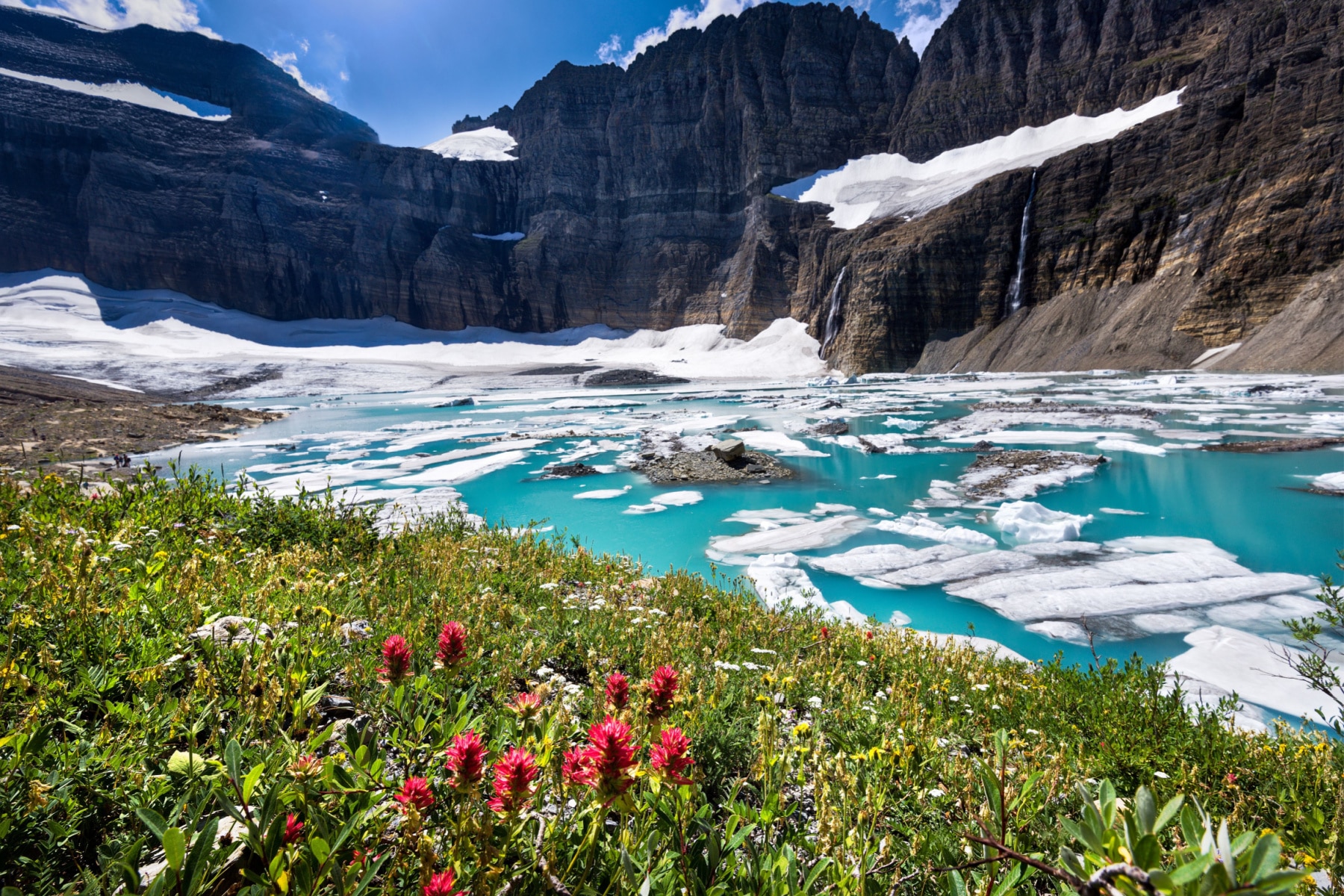
Article Overview: Grinnell Glacier Hike
The Grinnell Glacier hike in Glacier National Park, Montana, rests in a place where Earth, water (frozen or not), fire, and air collide flawlessly. The scenery stuns with every step of the nearly 11-mile hike along gray ledges that complement aqua lakes lining the way.
The scenery leaves you breathless, and it has little to do with the 6,510-foot elevation. Summer offers the best season to hike the Grinnell Glacier, with July and August getting the most visitors.
I was in the July crowd in the summer of 2023 when 722,000 other people were at the park. I’d do it again in a heartbeat, even with a 4:00 am wake-up call.
Capture the glacier’s fleeting beauty while it’s still there. The photo below shows how much real estate the Grinnell Glacier has lost since 1887. Within 75 years, all of the Glaciers at Glacier National Park will likely disappear.
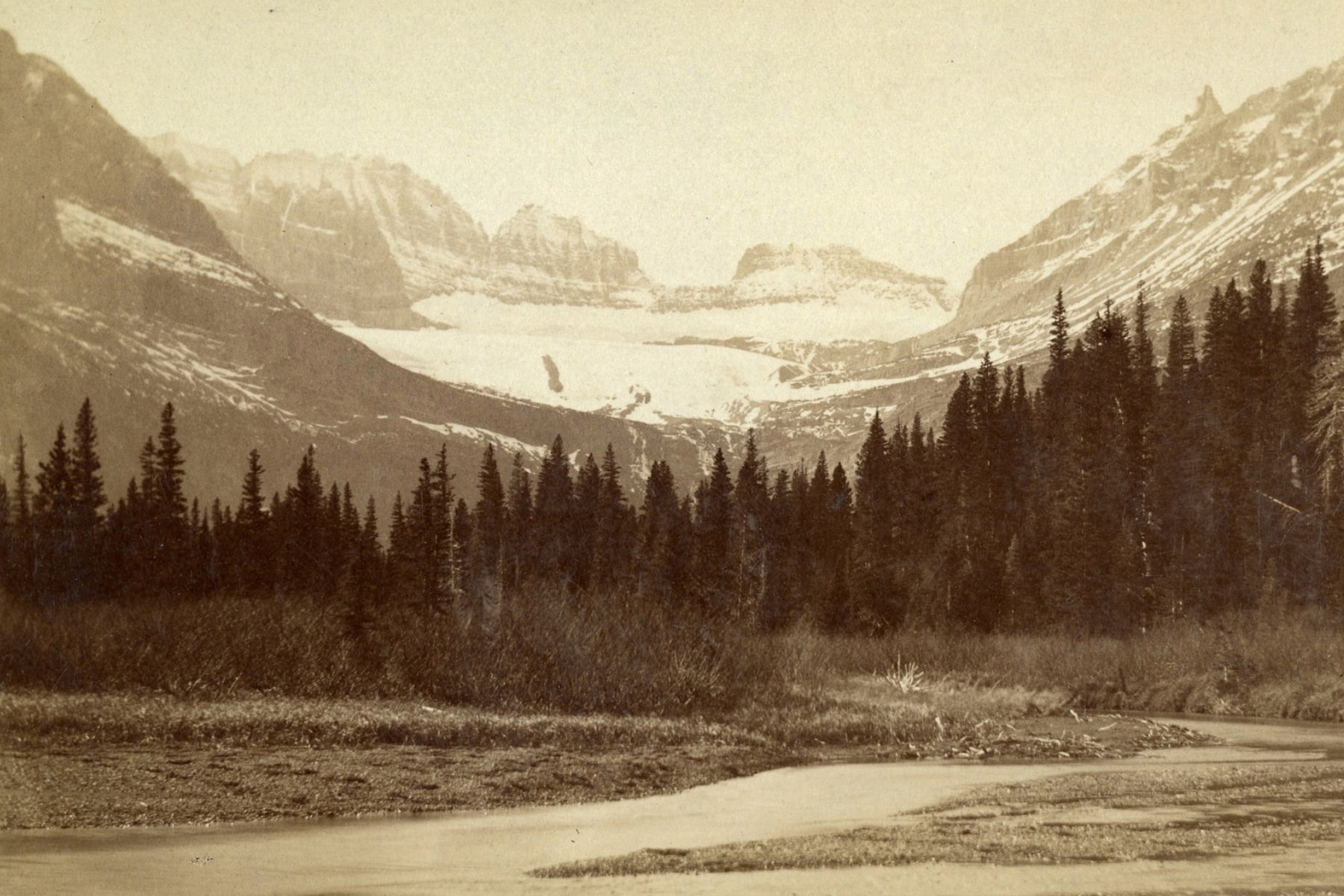

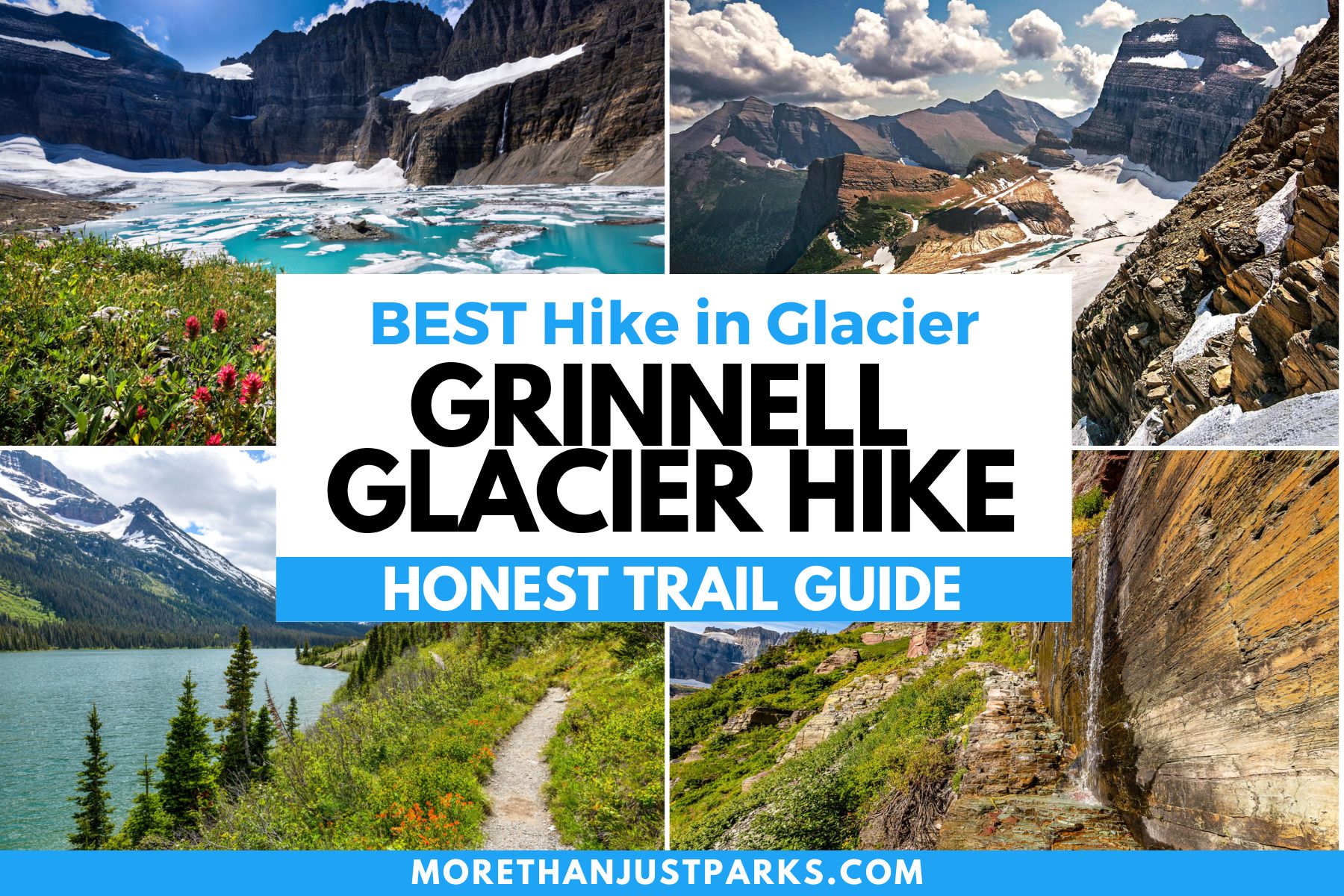
Grinnell Glacier Hike
Table of Contents: Grinnell Glacier Hike
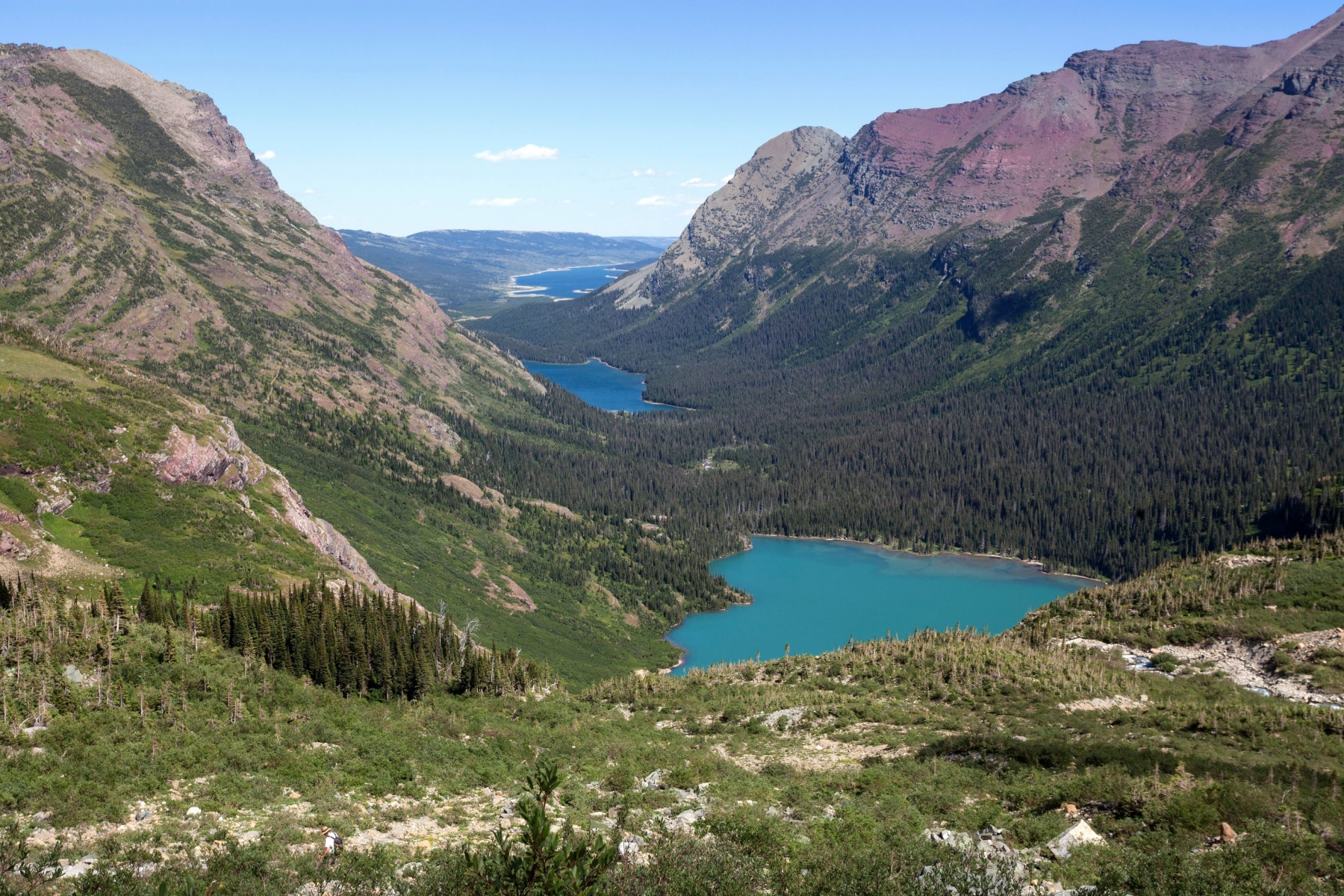
6 Quick Details About Glacier National Park
- The trailhead awaits in the Many Glacier area of the park, which requires vehicle reservations from July 1 through September 8 between 6:00 am and 3:00 pm. Outside of that time, parking is first-come, first-served. If you have booked a hotel or a tour, you won’t need a parking reservation.
- Entrance fees are $35 per vehicle or $20 per person. Purchase the America the Beautiful Pass to get access to Glacier and all the other national parks for just $80 a year.
- The beautiful scenery sparkles in the sunlight, but you need sunscreen and solar glasses to protect your eyes from the brightness, even with overcast skies.
- Bears roam this area, so bring bear spray with you. Keep it in an easy-to-reach spot, like hooked on your hip. Don’t leave it inside a backpack – you wouldn’t have that much time if a bear came charging.
- Bring a guidebook and/or a map. You can’t rely on cellular service on the trail. Check out our gathering of hiking apps for offline map options.
- This is our favorite hotel in Glacier National Park for the Grinnell Glacier hike. It is outside the park, but you won’t deal with the in-park traffic, either.
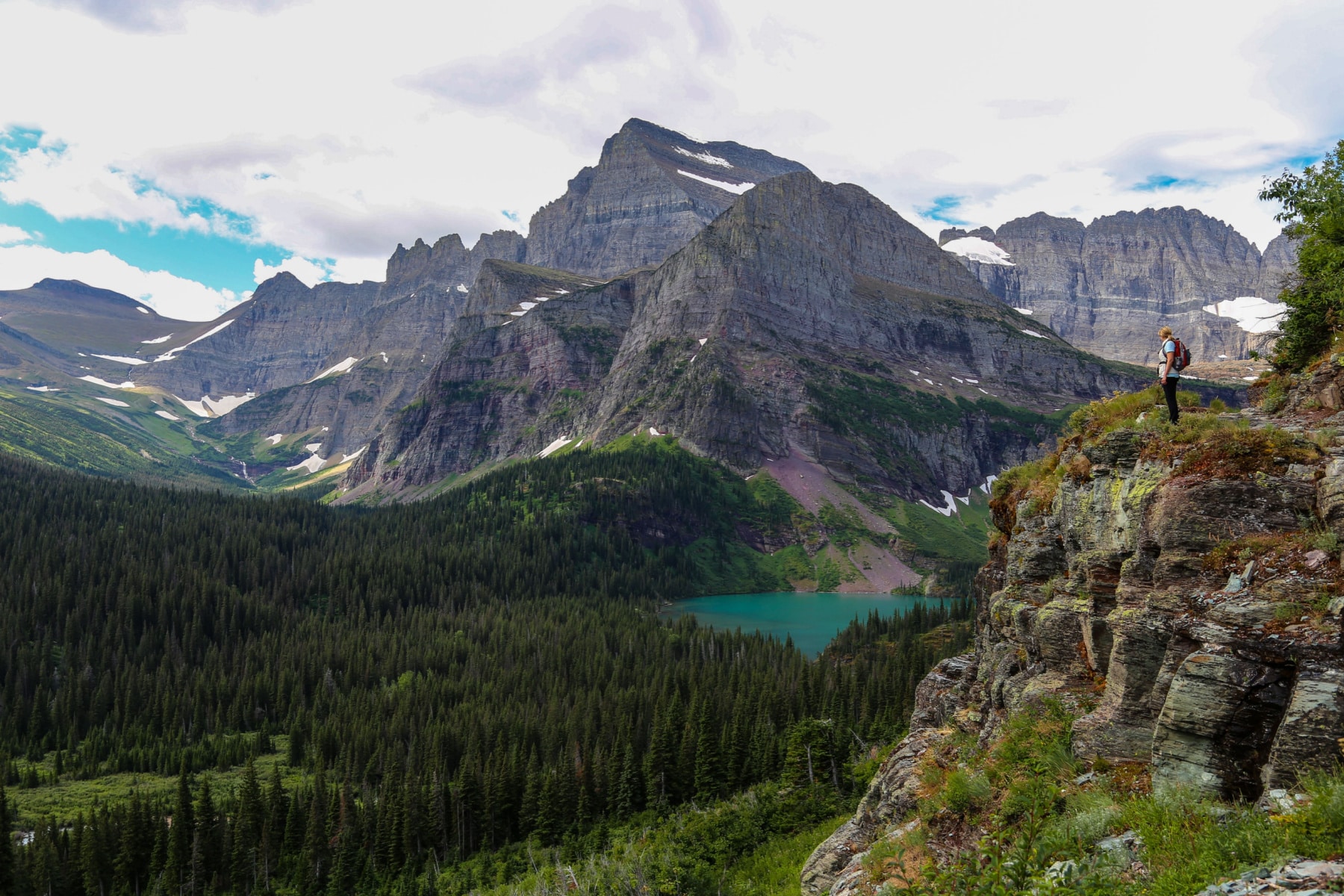
Grinnell Glacier Boat Ride
The hike to Grinnell Glacier passes two lakes and several strenuous spots, but many people choose to shave four walking miles by taking boats across two lakes. If you go on foot only, expect to hike roughly 11 miles roundtrip.
Boats can cut off the first 3.4 miles of the trail, which follows the flat land along Swiftcurrent Lake and Lake Josephine. Walking the trail is free with park admission, but the boat rides through Glacier Park Boats will cost extra and reservations are strongly recommended.
Here’s what to expect on the Grinnell Glacier Boat Shuttle.
- COST: Expect to pay less than $40 per person. Anyone 4-12 years old costs around $10, and children under four are free. Hikers can also book a one-way boat ride, which is a popular option for the return trek from Grinnell Glacier.
- WHAT: Whether just sightseeing or hiking Grinnell Glacier, the boat ride takes you across two lakes with a short but steep walk between Swiftcurrent Lake and Lake Josephine.
- WHEN: Tours/boat shuttles run daily from the Many Glacier area, usually starting in early June and running through mid-September.
- TIME: At peak season, seven departure times are available from 8:30 am through 5:00 pm.
If you have a boat reservation for the return hike, don’t be late – the boat won’t wait.
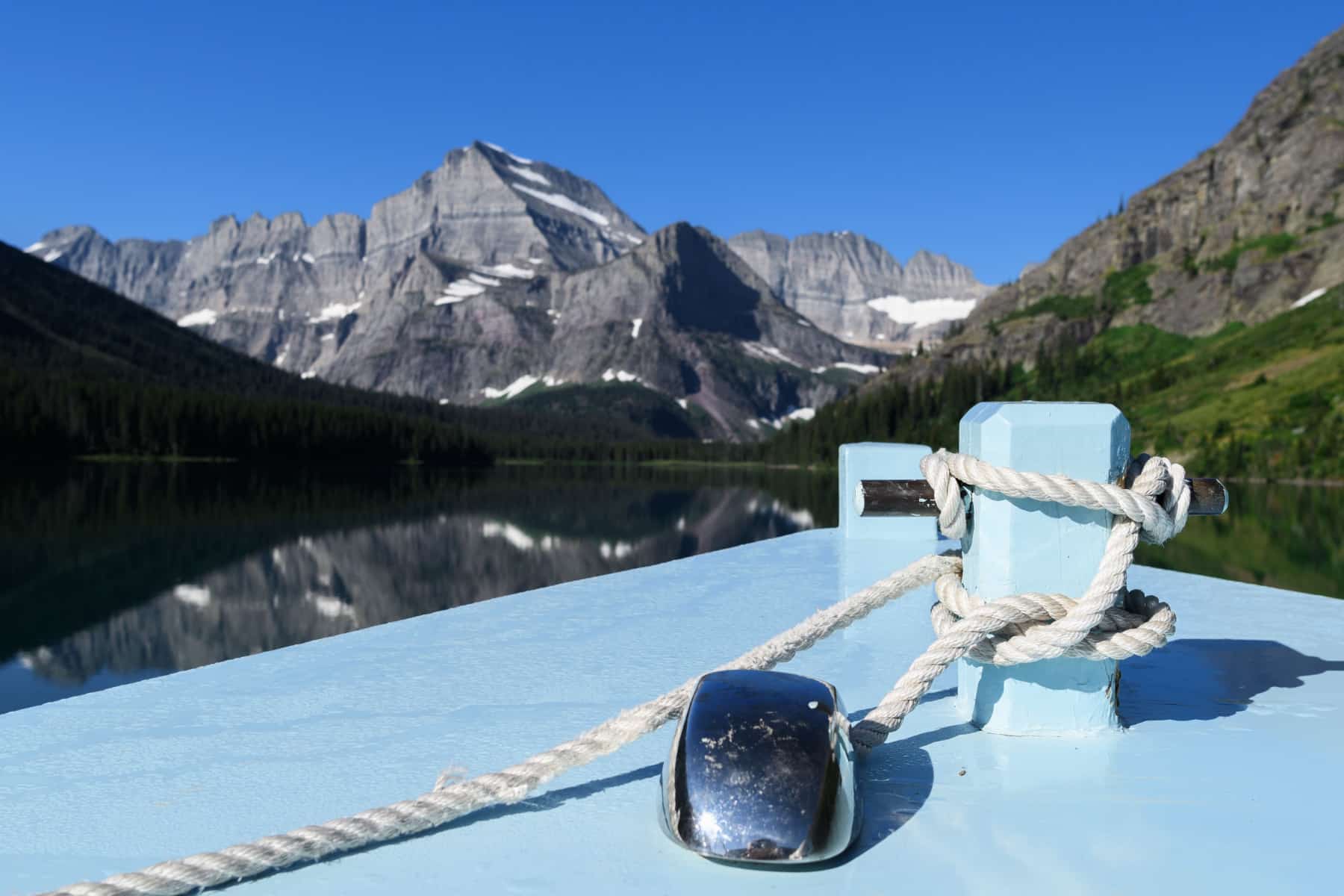
The Grinnell Glacier Hike: Step-by-Step Guide
Elevation: 4,900 feet at trailhead to 6,150 feet at summit
Length: 10.6 miles
Time: 8-10 hours, depending on how long you stop and explore the glacier or at views along the way.
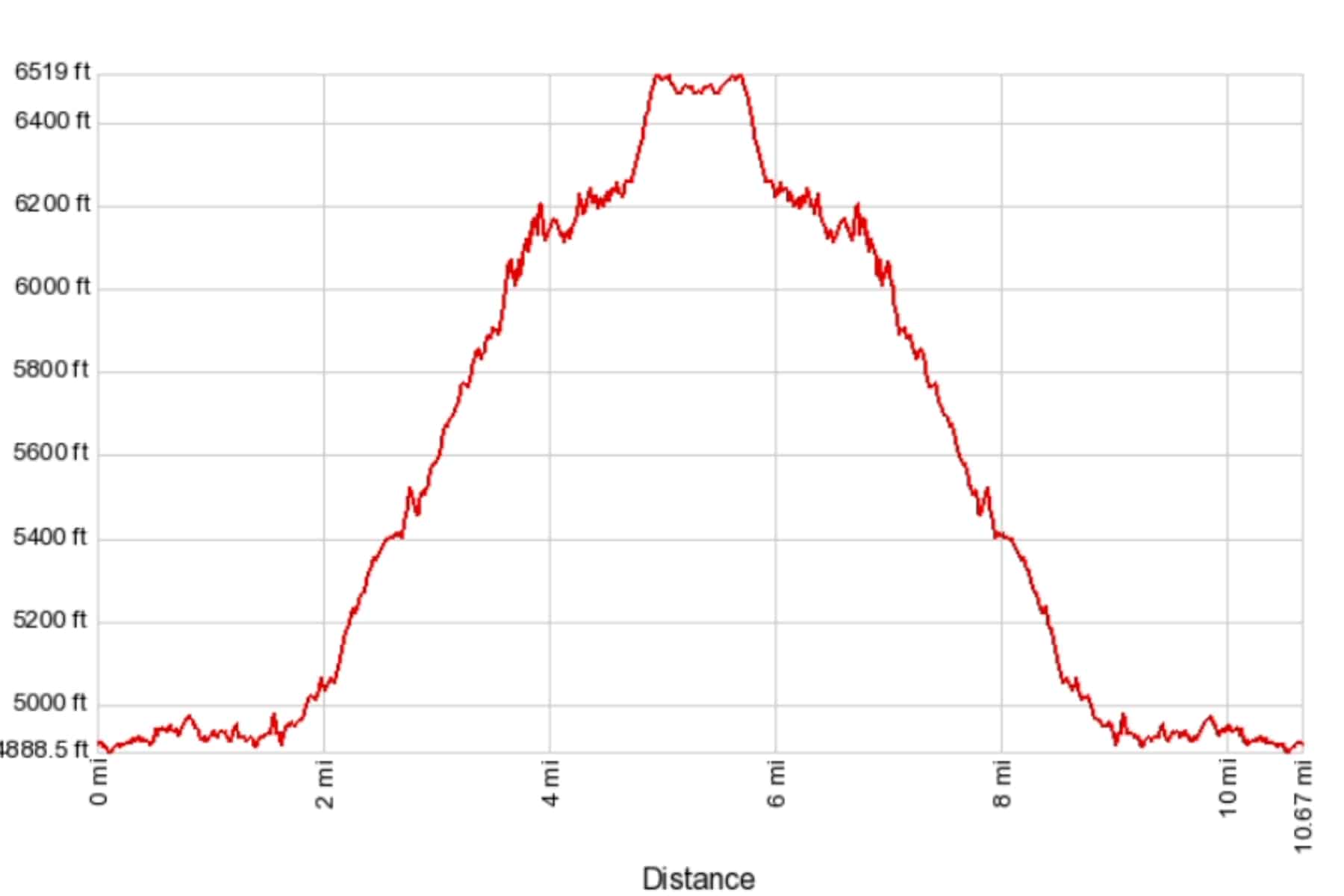
I am literally the worst about hiking in a rush to get to the pinnacle view. This is one trail where I couldn’t stop myself from soaking in the views. Be prepared for a longer hike because of the immersive experience.
From the Trailhead Past the Lakes
The trail starts near the Many Glacier Ranger Station. The trail hugs the shore of the aforementioned lakes for the first three miles or so. This part is relatively flat and will make you question why anyone said this could be a moderate or strenuous hike. That will soon change.
Summer visitors will notice this part of the trail is lush. That brings two concerns—ticks and bears. Just keep talking to let the bears know you are there and stay on the trail and/or boardwalk to avoid contact with the leaves where ticks wait to attach.
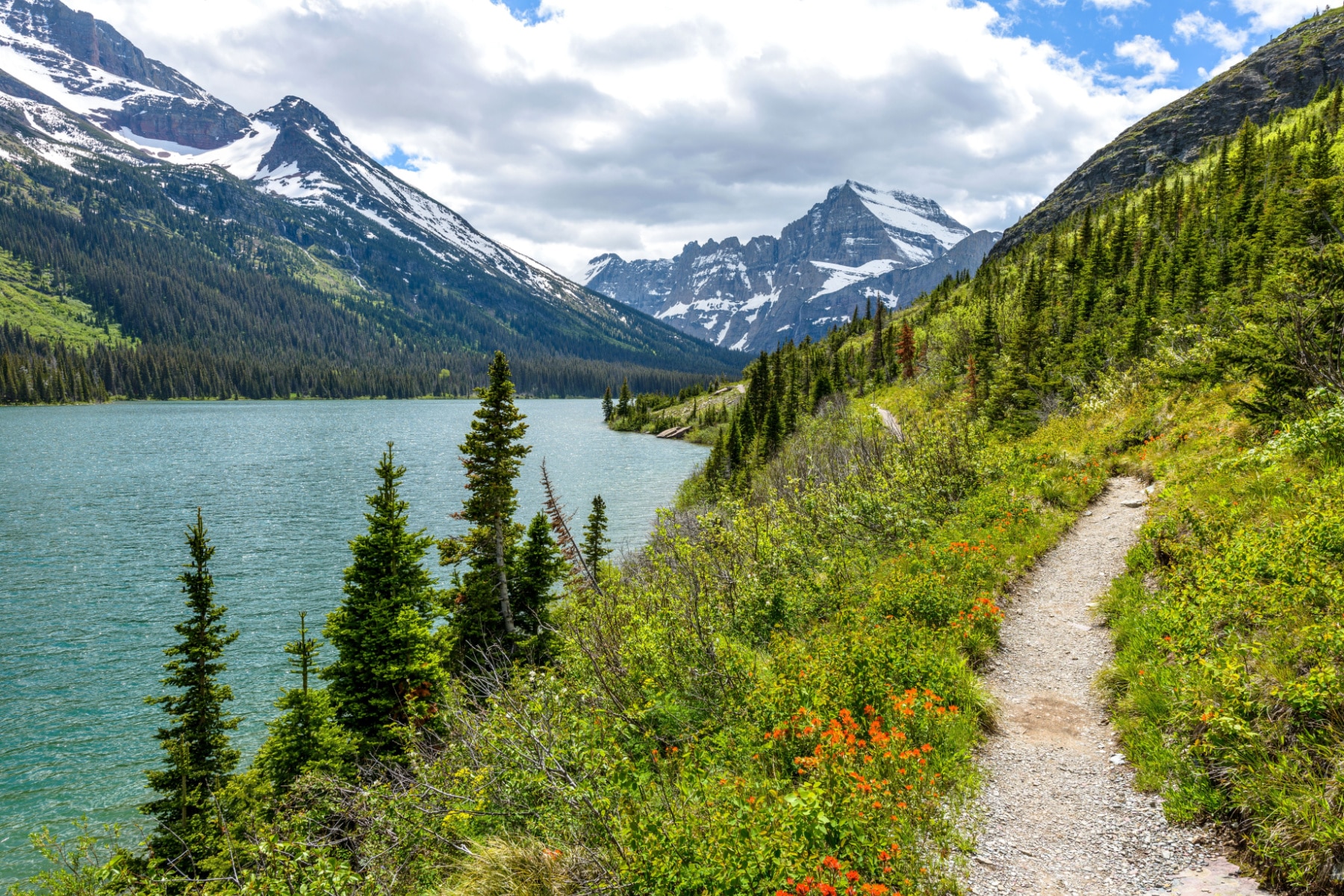
The Up Hill Hike to the Big Switchback
After you’re past Lake Josephine, the trail reveals its true strenuous self. With a total incline of nearly 2,100 feet, it’s time to see some of the most stunning sites in the state of Montana. To your left, you’ll see the turquoise blue lakes below as the sharp drops grow steeper.
You’ll walk the cradle of a mountain. The trails range from as wide as a sidewalk or as narrow as just a few footprints. I did get a slight dose of vertigo from looking down. However, the “fear of heights” gauge is nothing compared to places like Angels Landing at Zion or Half Dome at Yosemite.
This is also a rocky path with loose rocks below you and water trickling out of the side of the rock face as you go. Watch your steps carefully, as there is no guardrail.
About a mile from Lake Josephine, you’ll come to the one and only major switchback of the trail. This is where the trail will be closed if there is avalanche danger.
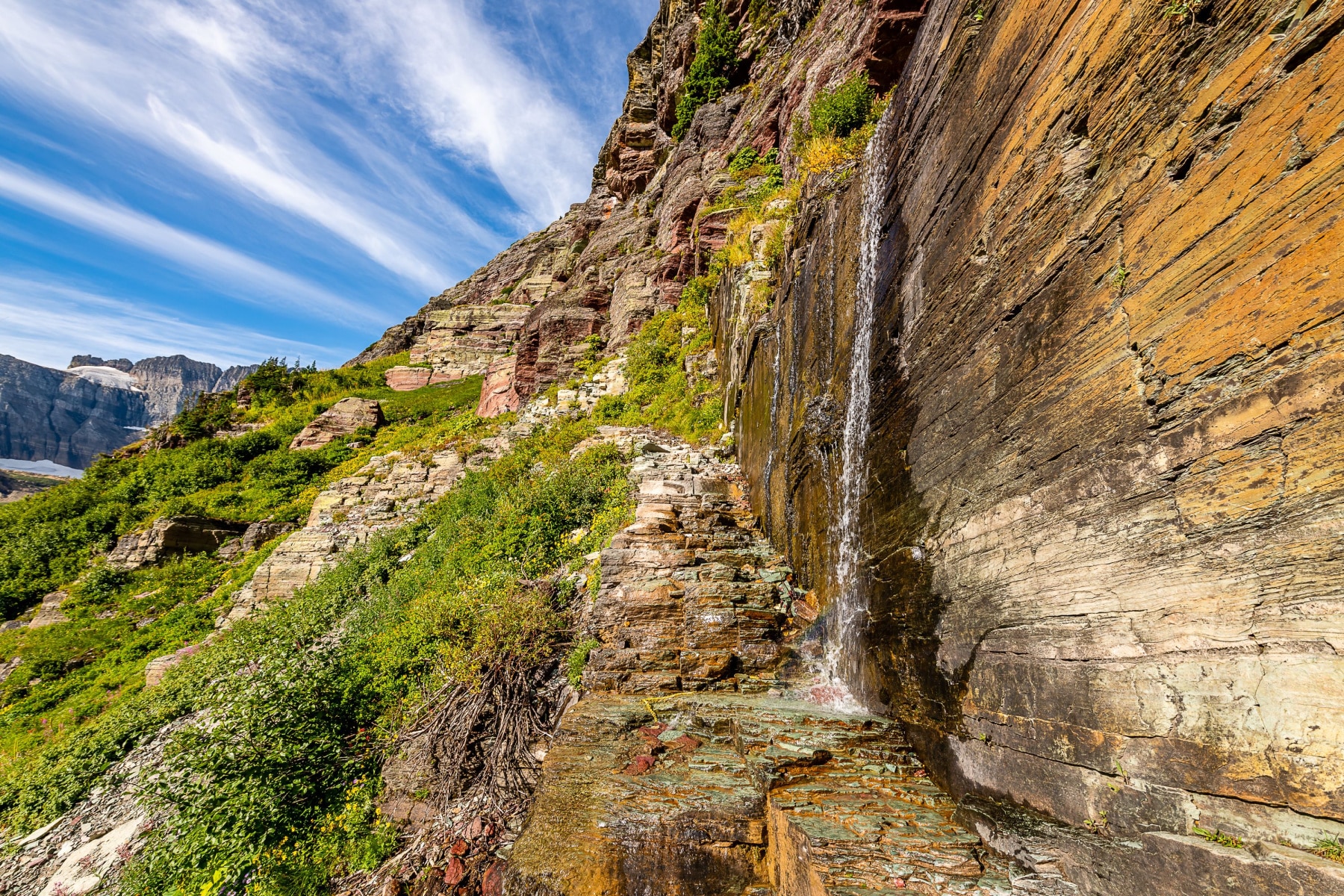
Big Switchback to Final Ascent
I took a lot with me on this Grinnell Glacier hike, and I don’t mean the stuff in my backpack. My emotional baggage had been wearing me down with stress and burnout. This trail made every step slough off the emotional rot and brought a higher sense of self. I can’t stress it enough – give yourself extra time to enjoy the dazzling views on this trail.
As you hike, you see the same dazed look on everyone else’s face. It’s transcendent here on this exhaustive path that seems to replace the energy you’re burning immediately. The trail widens and narrows, giving plenty of places to stop and take photos, meditate, or just… be.
You’ll eventually come to the Grinnell Glacier Picnic Area, where the last pit toilet of the trail is located. By now, you see Grinnell Glacier in front of you on the trail, but there’s a big climb to get to the mother-of-all-views.
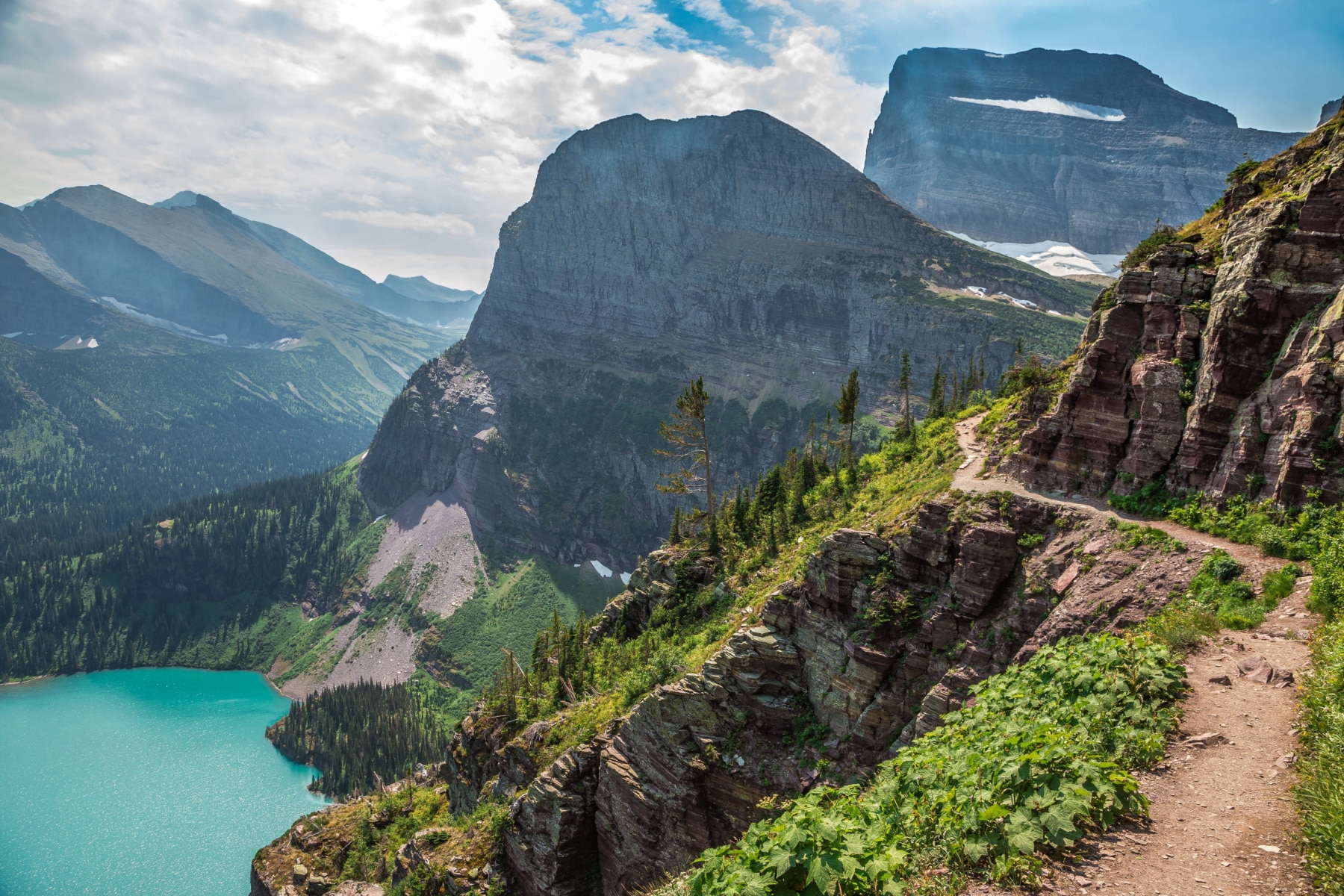
The Final Steps to Upper Grinnell Lake
You’ll burn your calves taking the final steps (some literal, some figurative) until you reach a flat overlook with Upper Grinnell Lake in front of you. Walk down to the side of the lake where the rocks, water, and cascades meet.
The trail is relatively safe until you reach a sign warning you about the dangers of going further. Of course, going further means actually going to Grinnell Glacier.
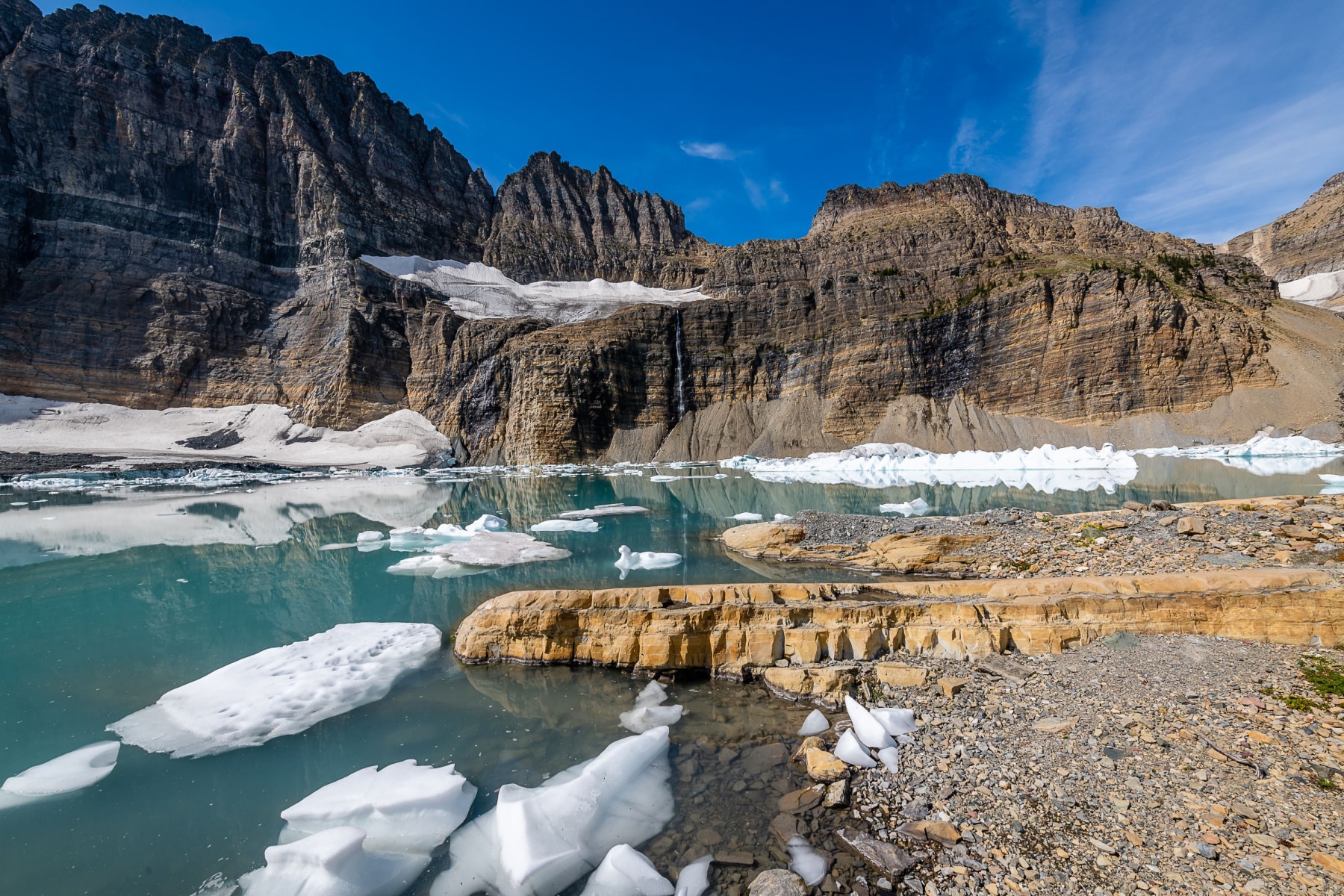
The Grinnell Glacier
As you get closer to the glacier, you can’t trust anything you are standing on. It’s nearly impossible to tell if you’re on bedrock, floating rock, or ice with a rocky appearance on top.
Walking on the glacier is downright dangerous. Thin layers of snow can cover the hidden crevasses. One step, and you could plunge right in.
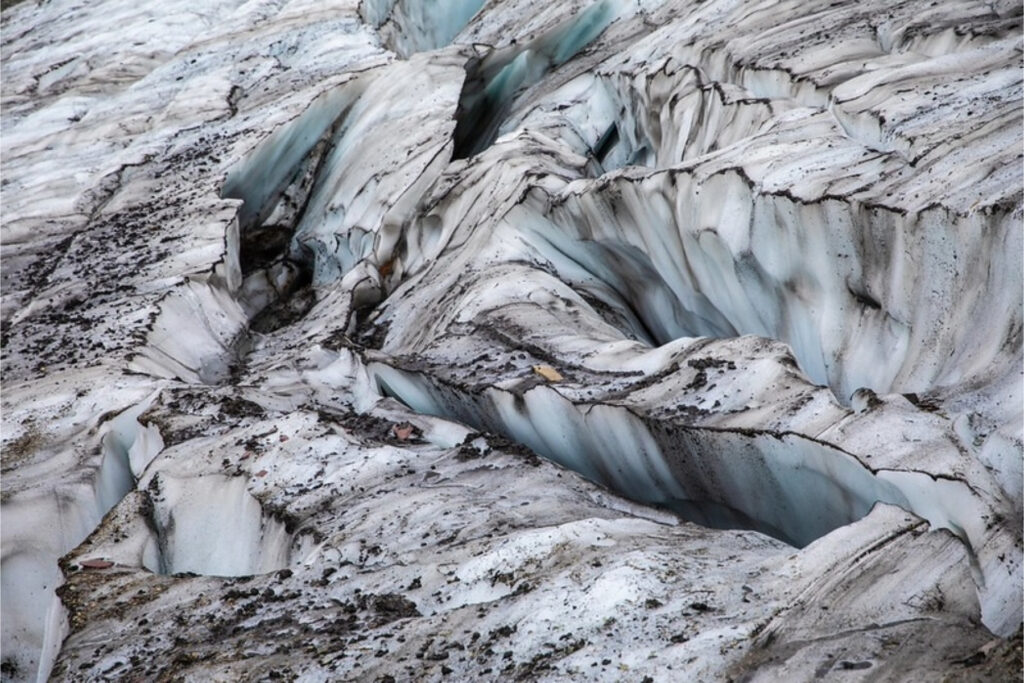
The glacier itself looks like a behemoth, and it’s hard to imagine how much it has shrunk during the past 175 years. In 1850, the glacier was 710 acres. It’s now 115 acres. Between 1966 and 2015, Grinnell Glacier was reduced in size by 45%.
Check out the “Then & Now” photos on the Glacier National Park website to get great visuals of the shrinkage.
The Return Hike
This is an out-and-back trail, so you’ll take the same route to get back with the benefit of going downhill during the return trip. Do not rush this part, as different sections of the trail will be wet or slippery from the wear and tear of the day.
Grinnell Glacier is one of the most popular hikes in the park, so expect crowds. Those dreams of having the trail to yourself aren’t realistic on an average July or August day.

Map of Grinnell Glacier Hike
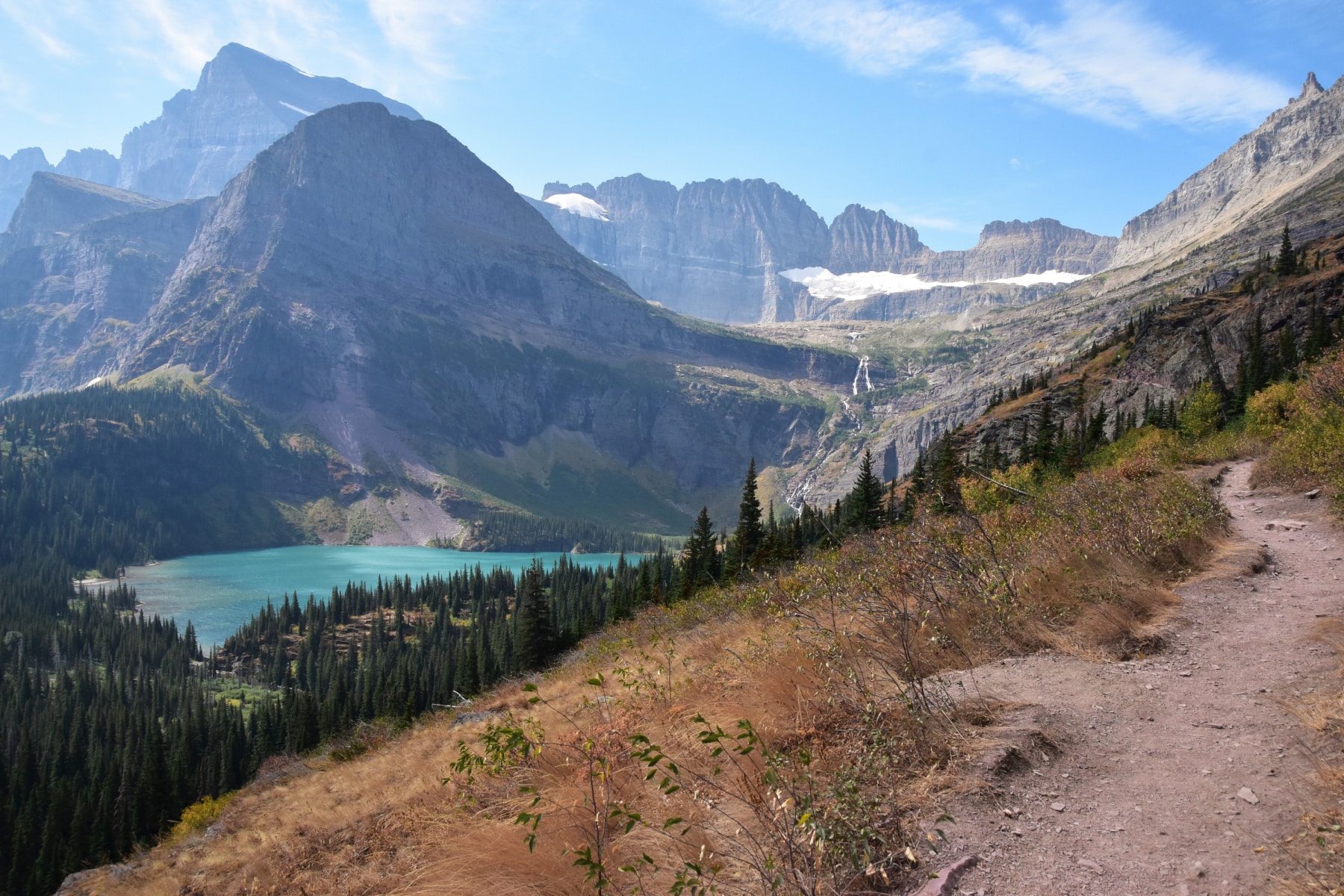
WATCH: Grinnell Glacier Hike Tour
More Glacier National Park
Our expansive coverage from exploring this international park doesn’t stop here. Check out our best things to do at Glacier National Park and the best hikes. We’ll even help plan your itinerary!
Grinnell Glacier Hike FAQs
The color is from the way the water absorbs the spectrum of light. Glaciers bulldoze the rocks into fine powder, which follows snow run-off to the lake. The slow-to-sink rock particles absorb the indigo colors. Water soaks in the longer wavelengths of red, orange, and yellow. That leaves the beautiful blue and green mixtures to shine.
Glacier has up to 1,000 bears, both grizzly and black bears. Regardless of bear type, you should always make noise and talk to the bears. Most people will shout, “HEY, BEAR!” as they hike.
You should carry bear spray with you at all times, and if you are also visiting Canada during your trip to Glacier National Park, make sure you bring USEPA-approved bear spray. Otherwise, you might get it confiscated at the border.
Snow and ice will (obviously) be present throughout the year, so I don’t head to this park without crampons to help with slick spots. An ice pick and walking sticks are great ideas to navigate the more dangerous spots of this trail.
You should also carry an avalanche beacon, probe, and shovel, especially when we know Grinnell Glacier’s trail is in prime avalanche territory for part of the year.
No. The water can have bacteria and cause terrible illnesses like Giardia. The only potable water on the trail is at the trailhead. You can bring water filtration tools to clean water along the way, but you should start with a gallon of your own water.
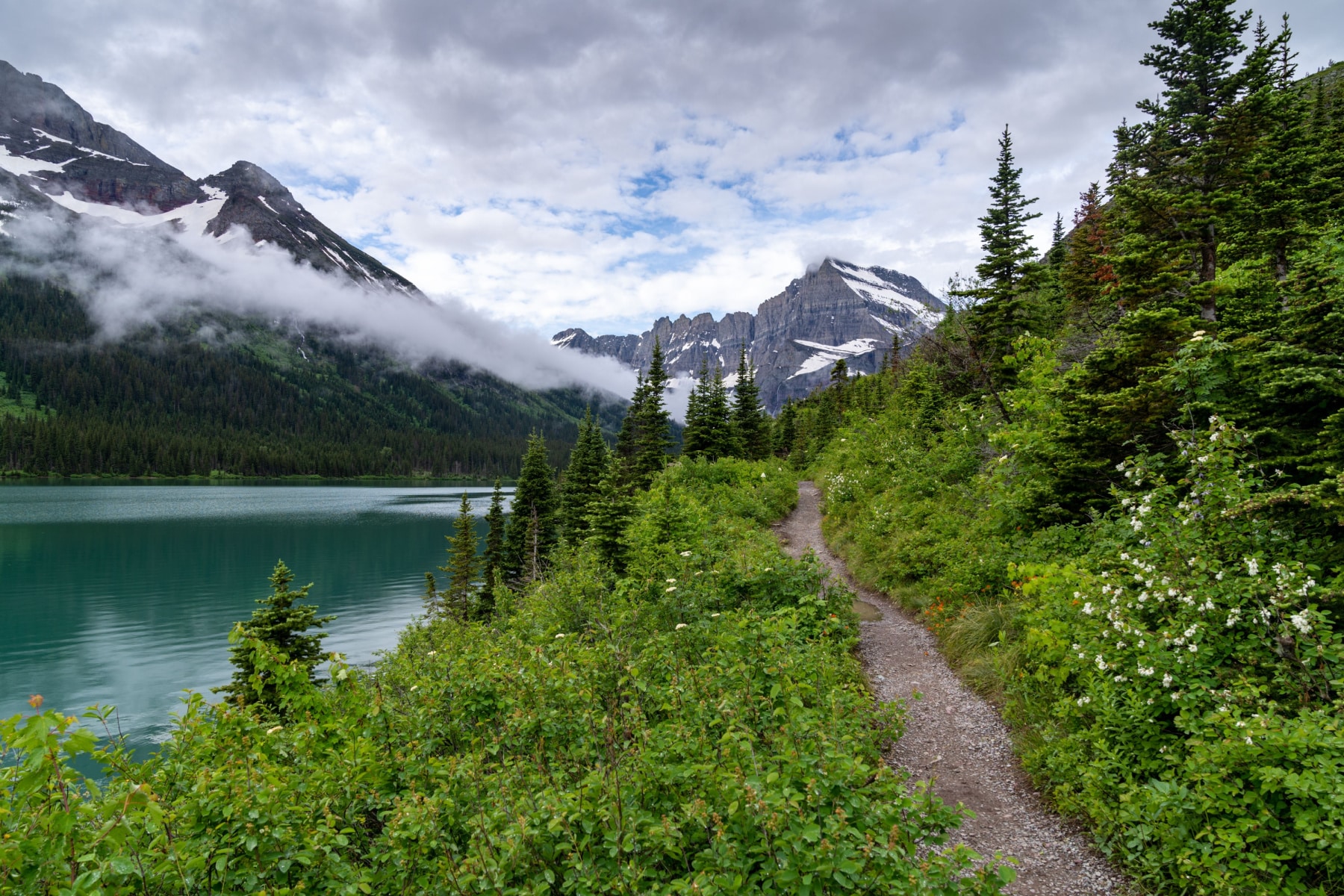
The Name Behind the Grinnell Glacier Hike
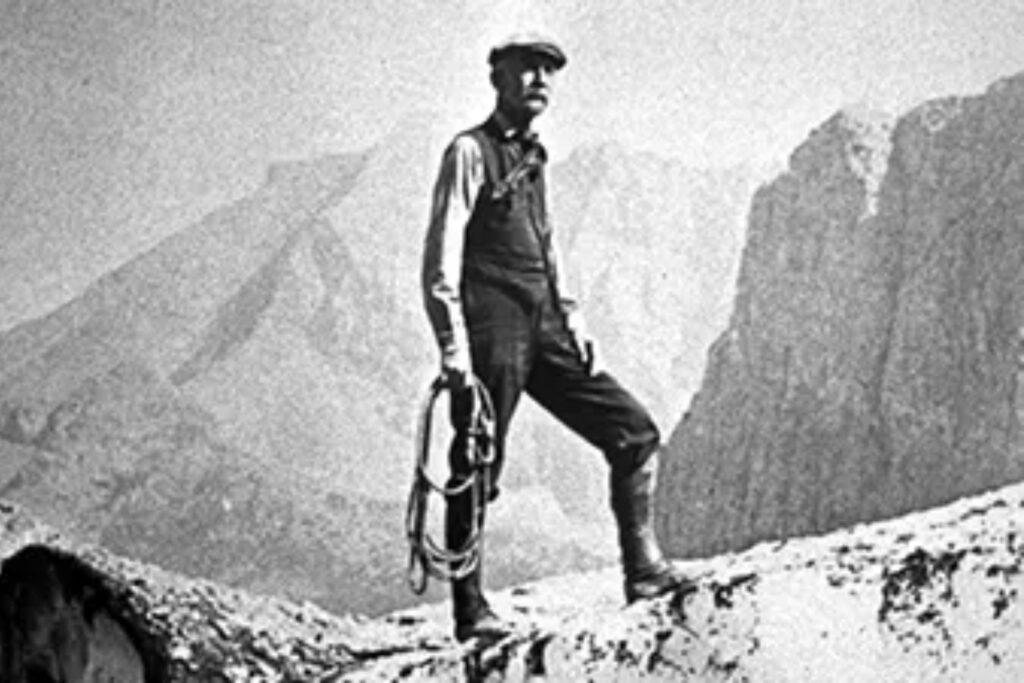
The glacier gets its name from George Bird Grinnell (1849-1938), the editor of Forest & Stream magazine. (It’s now known as Field & Stream.)
Grinnell came to the area we know as Glacier National Park in 1885 and fought vigorously for Glacier National Park to be created. Records show his first steps on what would become Grinnell Glacier was in 1887.
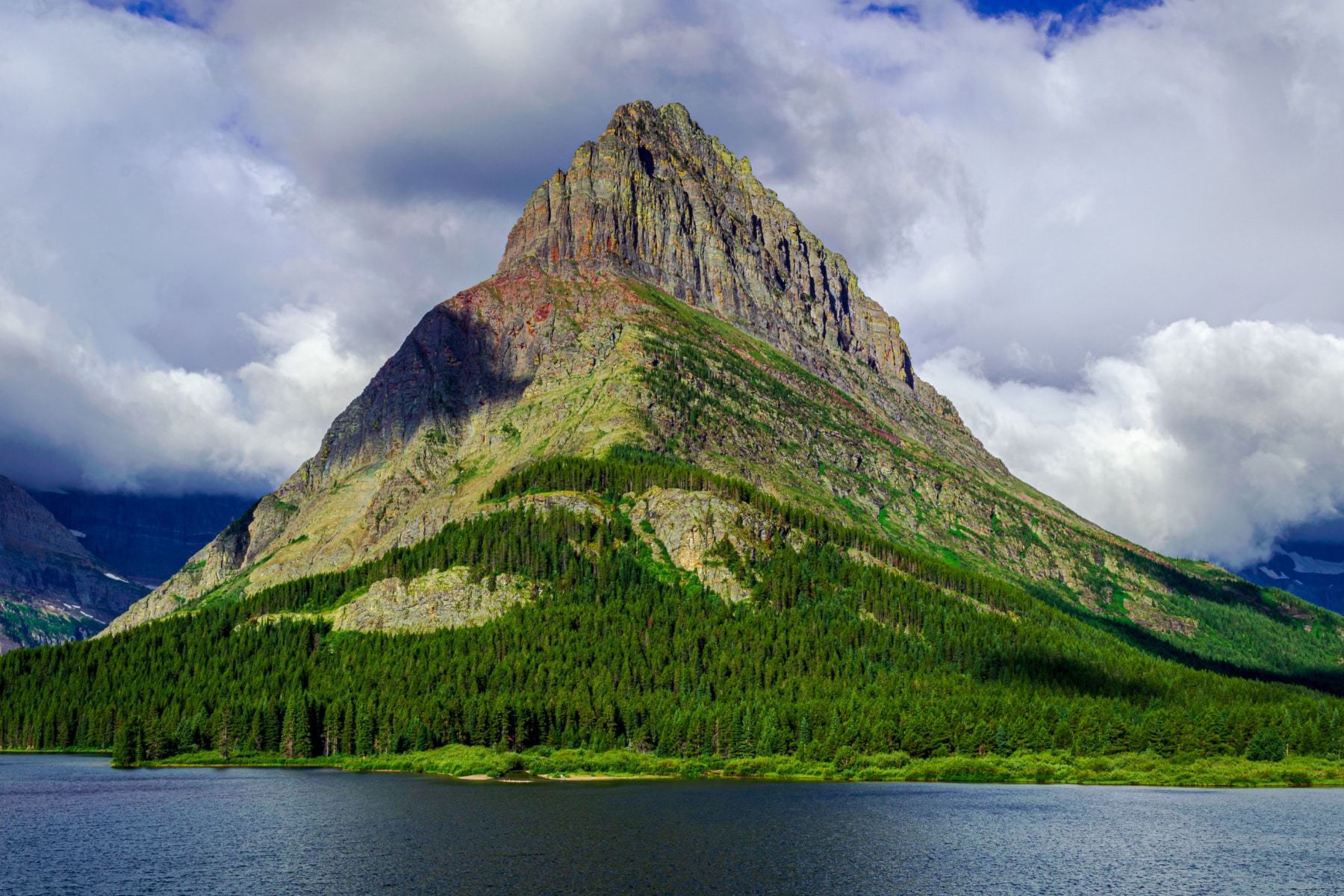
Pin Grinnell Glacier Hike
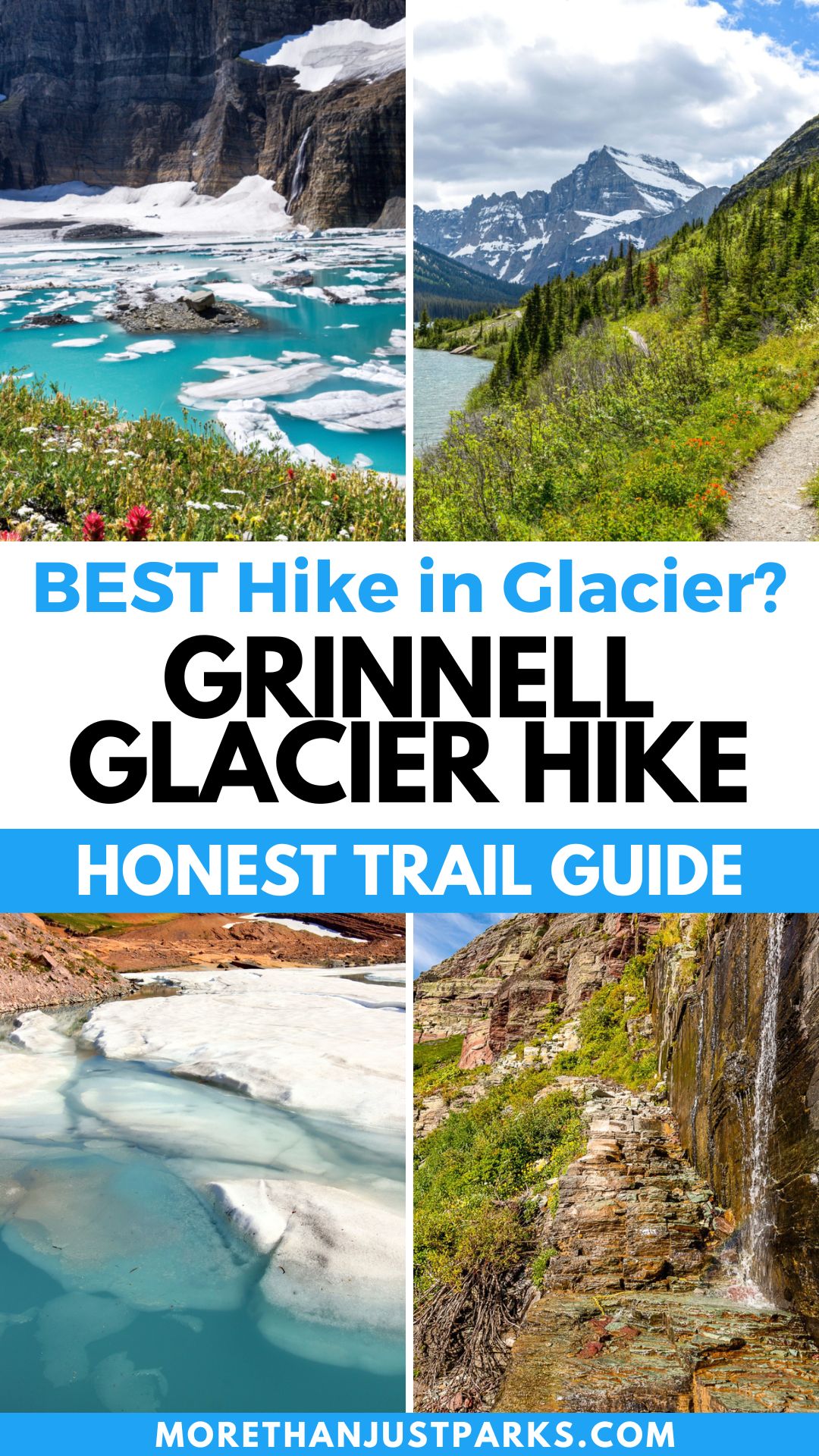
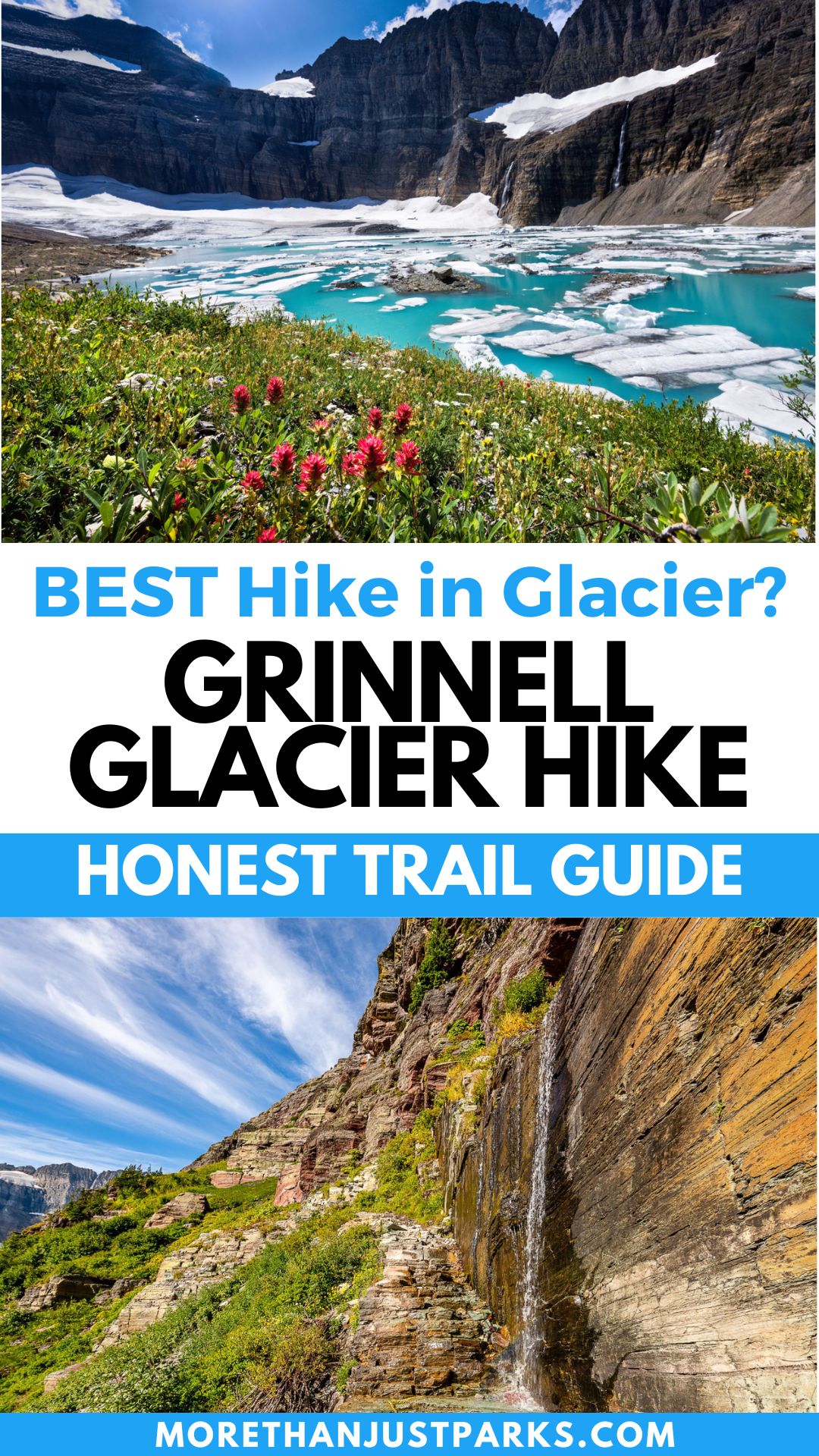
Helpful Related Links
Ready for more Glacier National Park hikes? 15 BEST Bikes in Glacier National Park
Best Things to Do Glacier NP: 15 Epic Things to Do at Glacier National Park
Glacier National Park Itinerary: Ultimate 3 Day Glacier National Park Itinerary
Glacier National Park Hikes: 15 Best Hikes in Glacier National Park
Montana National Parks: 10 Amazing Montana National Parks to Visit
Grand Teton Hikes: 18 EPIC Grand Teton National Park Hikes (Photos + Guide)
Grand Teton Guide: Grand Teton National Park Ultimate Guide
Things to Do Grand Teton: 17 EPIC Things to Do Grand Teton National Park
Grand Teton Maps: The Best Maps for Grand Teton National Park
Things to Do Yellowstone: 15 BEST Things to Do Yellowstone National Park
Yellowstone Facts: 10 AMAZING Yellowstone National Park Facts
Best Airports Near Yellowstone: The BEST Airports Near Yellowstone National Park
The Wyoming National Parks: 10 EPIC Wyoming National Parks: The Complete Guide (+ Photos)
Things to Do Wind Cave: 10 Epic Things to Do at Wind Cave National Park
Visiting Mount Rushmore: 15 Helpful Tips for Visiting Mount Rushmore


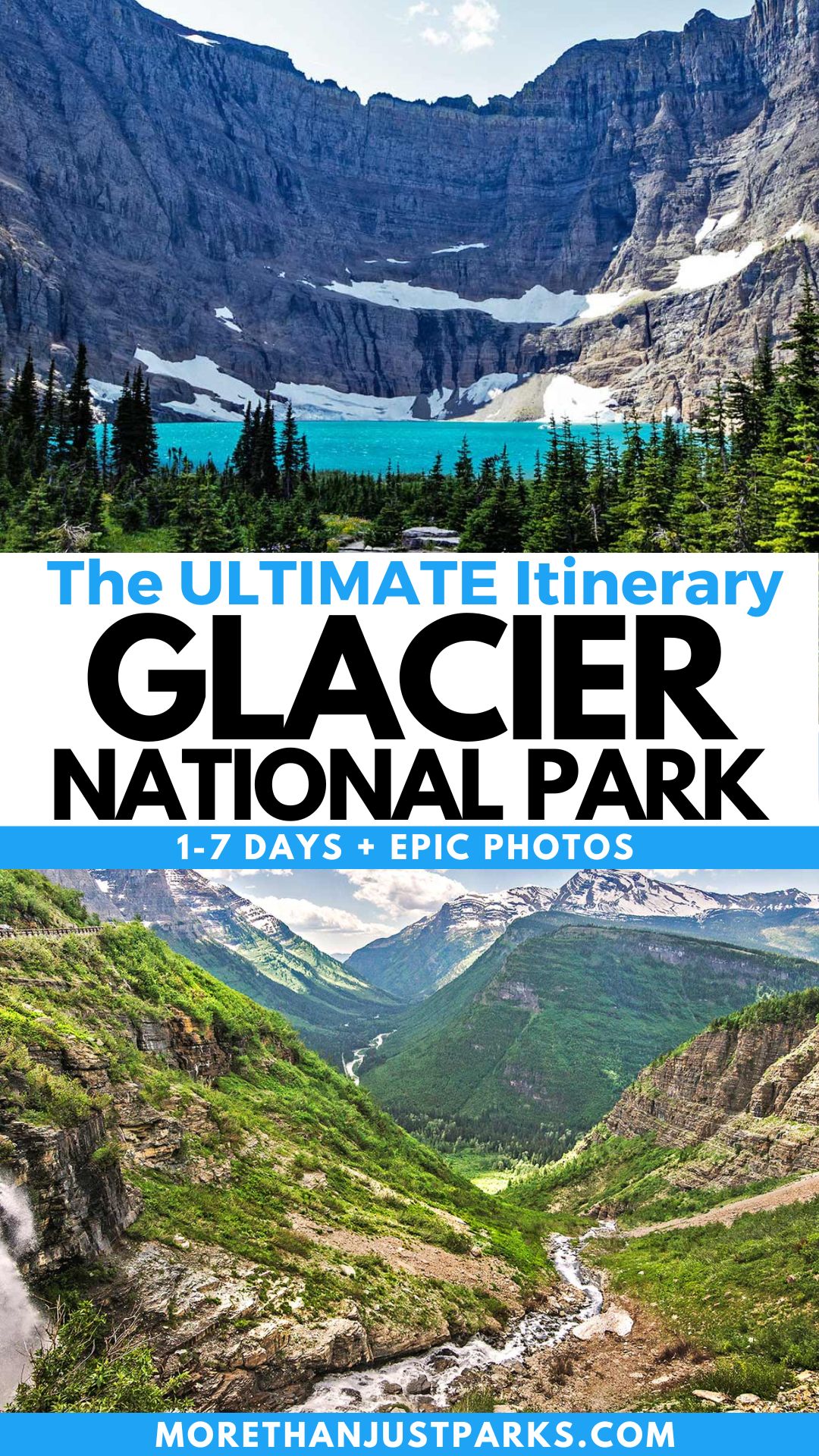
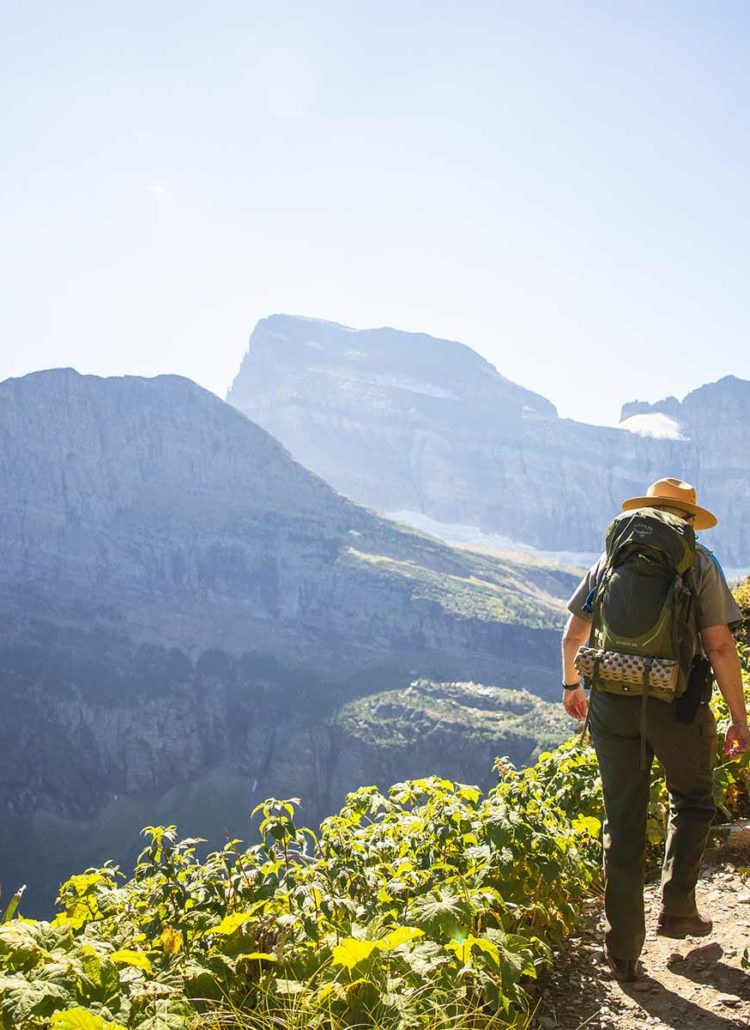

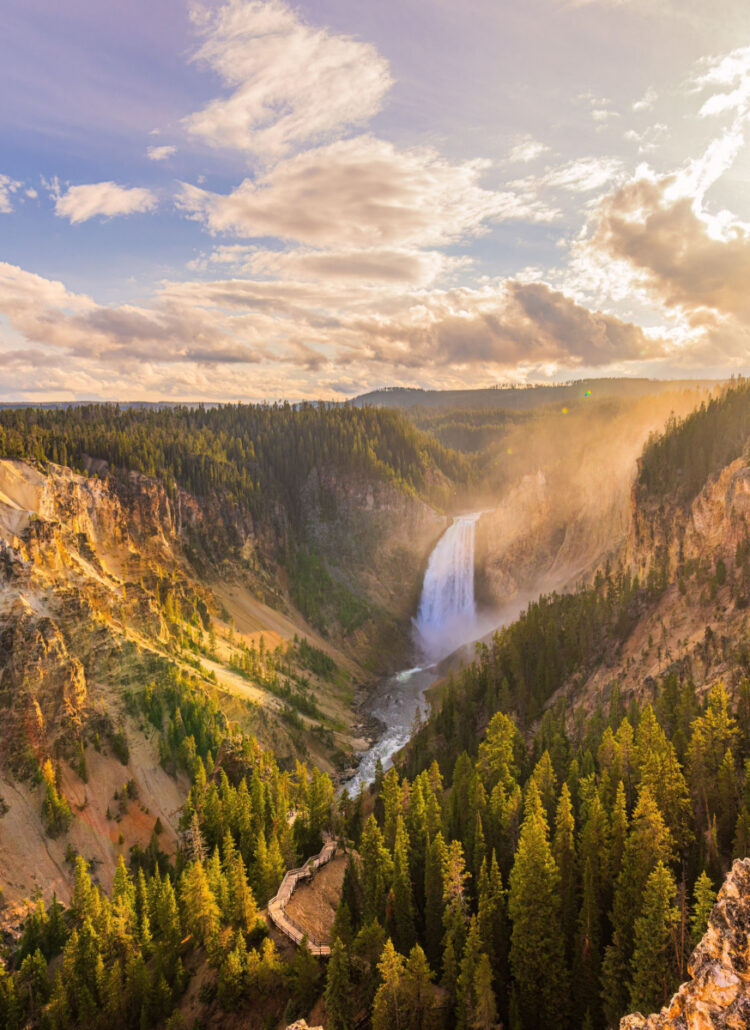
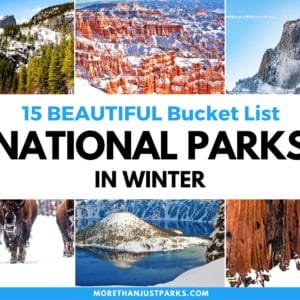

Leave a Reply